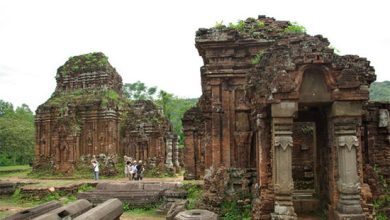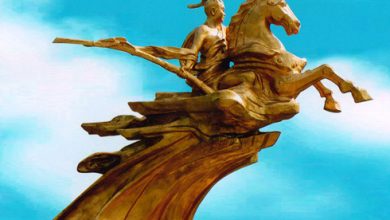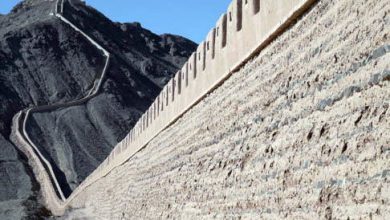Complex of Hue Monuments
Established as the capital of unified Viet Nam in 1802, Hué was not only the political but also the cultural and religious centre under the Nguyen dynasty until 1945. The Perfume River winds its way through the Capital City, the Imperial City, the Forbidden Purple City and the Inner City, giving this unique feudal capital a setting of great natural beauty.
Hué represents an outstanding demonstration of the power of the vanished Vietnamese feudal empire at its apogee in the early 19th century. The complex of monuments is an outstanding example of an eastern feudal capital and of the planning and construction of a complete defended capital city in a relatively short period. The integrity of town layout and building design make it an exceptional specimen of late feudal urban planning.
Hué served as the administrative centre of southern Vietnam in the 17th and 18th centuries. Gia Long, first ruler of the Nguyen dynasty, made it the national capital of united Vietnam in 1802, a position that it held until 1945. It was selected because it is situated in the geographical centre of the country and with easy access to the sea. The new capital was planned in accordance with ancient oriental philosophy in general and Vietnamese tradition in particular; it also respected the physical conditions of the site, especially the Perfume River and Ngu Binh Mountain (known as the Royal Screen). The relationship between the five cardinal points (centre, west, east, north, south), five natural elements (earth, metal, wood, water, fire), and five basic colours (yellow, white, blue, black, red) underlies the conception of the city, and is reflected in the names of some important features. The Perfume River, the main axis, divides the capital in two.
Four citadels or defended enclosures made up the city: Kinh Thanh (Capital City), for official administrative buildings; Hoang Thanh (Imperial City) for royal palaces and shrines; Tu Cam Thanh (Forbidden Purple City) for the royal residences; Dai Noi (or Inner City); and Tran Binh Dai, an additional defensive work in the north-east corner of the Capital City, designed to control movement on the river. A fifth fortress, Tran Hai Thanh, was constructed a little later to protect the capital against assault from the sea. Planning lasted from 1803 to 1805, and it was not until 1832 that construction was complete. The new capital was much larger than its predecessor, Dong Trang, and encompassed several villages as well. The fortress itself was modelled on the European style of Vauban, the first of its type in South-East Asia, but the complex suffered considerably as a result of military operations in 1885, 1947 and 1968.
The main enceinte, the Capital City, is square in plan, each side measuring 2,235 m. The defensive walls have six projecting bastions on each side and ten gates. The external defensive works comprise a berm, ditch, and glacis. The buildings inside the Capital City include various former ministerial buildings, the Royal College and the Hué Museum. The Inner City is rectangular in plan and defended by brick walls, supplemented by a moat and wide berm; there is a single entrance on each of the walls. Inside it is divided by walls into a number of zones – the Great Ceremonies Zone, the Worshipping Zone, the residential zone of the King’s Mother and Grandmother, the storage and workshop zone, the garden and school zone for royal princes, as well as the Forbidden Purple City. The palaces within the Inner City are similar in style and design, set on a raised podium, with wooden trusses (usually ironwood), gilded and painted pillars and rafters, brick walls, and roofs of yellow- or blue-glazed cylindrical tiles. Roof edges are straight, and the decoration, both internally and externally, is abundant. Among the most important buildings are the Palace of Supreme Harmony, the royal reception hall; the Mieu Temple, the royal place of worship; the Queen Mother’s Palace; and the Pavilion of Dazzling Benevolence.
At the heart of the complex is the Forbidden Purple City, surrounded by brick walls. There is a single gate in the front wall, reserved for the use of the king, and the other walls have several entrances, each with a specific purpose. Originally there were over 40 buildings within the walls, but most are now in ruins and only their foundations survive.
Outside the Capital City there are several associated monuments of importance. These include the tombs of the Nguyen dynasty to the south of the Perfume River. Other structures along both banks of the river are buildings related to the spiritual life of the dynasty, including the Temple of Literature, the Esplanade of the Sacrifice to the Sun and Earth, the Royal Arena and the Temple of the Roaring Elephant, and the Celestial Lady Pagoda.
Historical Description
Hue served as the administrative centre of southern Vietnam (Dang Trong) in the 17th century and again in the 18th century. Gia Long, first ruler of the Nguyen dynasty, made it the national capital of united Vietnam in 1802, a position that it held until 1945. It was selected because it is situated in the geographical centre of the country and with easy access to the sea.
The new capital was planned in accordance with ancient oriental philosophy in general and Vietnamese tradition in particular; it also respected the physical conditions of the site, especially the Perfume River and Ngu Binh mountain (known as the Royal Screen). The relationship between the five cardinal points (centre, west, east, north, south), the five natural elements (earth, metal, wood, water, fire), and the five basic colours (yellow, white, blue, black, red) underlies the conception of the city, and is reflected in the names of a number of its most important features. The Perfume River is the main axis, dividing the capital into two.
The detailed planning was entrusted to Nguyen Van Yen, commander of an army unit specializing in the construction of citadels. Four citadels or defended enclosures made up the city Kinh Thanh (Capital City), for official administrative buildings; Hoang Thanh (Imperial City) for Royal palaces and shrines; Tu Cam Thanh (Forbidden Purple City) for the Royal residences (the two last-named are known collectively as the Dai Noi or Inner City); and Tran Binh Dai, an additional defensive work in the northeast corner of the Capital City, designed to control movement on the river. A fifth fortress, Tran Hai Thanh (Coastal Bastion), was constructed a little later to protect the capital against assault from the sea.
Planning lasted two years, from 1803 to 1805, and it was not until 1832 that construction was complete. The new capital was much larger than its predecessor, Dong Trang, and encompassed several villages as well. Over 30,000 workmen and soldiers were involved in the work, which involved filling in two small tributaries of the Perfume River and digging new moats and canals. The fortress itself was modelled on the European style of Vauban, the first of its type in southeast Asia.
The complex suffered considerably as a result of military operations in 1885, 1947, and 1968.






